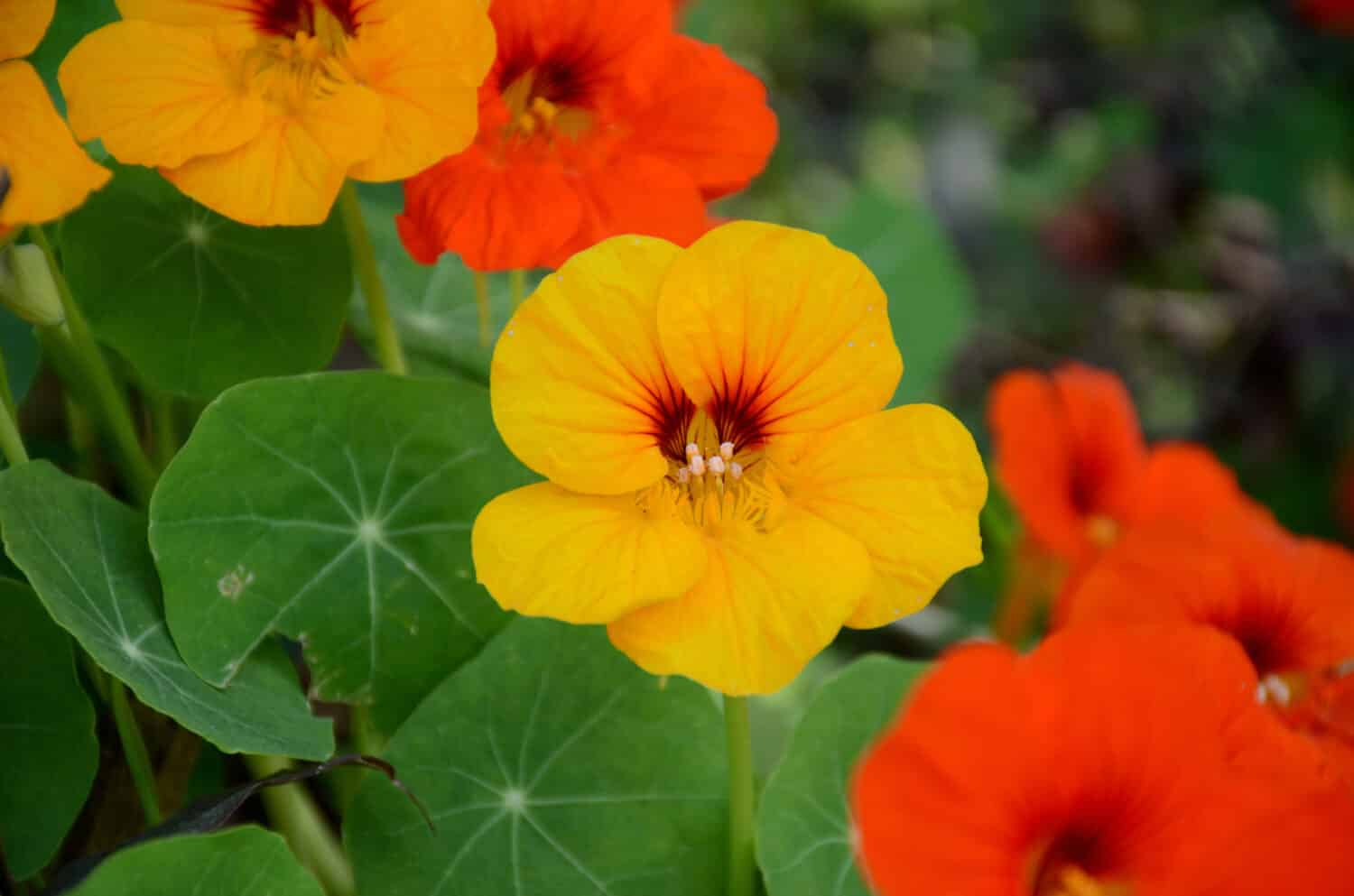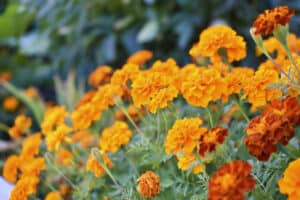Common flowers that start with the letter N include Nymphaea, Narcissus, Nierembergia, Nasturtiums, Nemesia, Nemophila, Nigella, Nicotiana, Night Phlox, Nerine, Nolana, and New Guinea Impatiens. Keep reading to learn more!
Flowers are nature’s captivating masterpieces, painting the world with their vibrant hues and enchanting aromas. From delicate daisies to majestic roses, the floral kingdom offers an endless array of mesmerizing blooms. Amongst this botanical tapestry, there exists a captivating group of flowers that start with N. In this article, we embark on a journey to explore and appreciate these unique and often lesser-known blossoms.
1. Nymphaea
Classification: Nymphaea sp.
The Nymphaea flower, commonly known as the water lily, is a remarkable aquatic flower that starts with N that exudes elegance and uniqueness. Its captivating beauty and distinct features make it a beloved symbol in various cultures around the world.
The Nymphaea flower showcases large, vibrant blossoms that float delicately on the water’s surface. Its petals come in a diverse range of colors, including pristine white, soft pink, radiant red, and sunny yellow. These petals unfurl in a captivating spiral pattern, creating a mesmerizing visual display. Long, slender stems support the flowers that emerge from the depths of ponds, lakes, and slow-moving streams, showcasing the plant’s aquatic habitat adaptation.
This remarkable flower thrives in freshwater environments with calm or slow-moving waters. One can find it in various regions worldwide, from temperate to tropical climates. Nymphaea flowers often inhabit ponds, marshes, and shallow areas of lakes, where their leaves, known as lily pads, float effortlessly on the water’s surface, providing a tranquil and enchanting sight.
What sets the Nymphaea flower apart is its unique adaptation to its environment. The lily pads not only serve as a resting place for the flowers but also play a vital role in photosynthesis, absorbing sunlight and converting it into energy for the plant. Additionally, the Nymphaea flower has a fascinating adaptation known as thermogenesis. It can generate heat, allowing the flower to bloom and emit its fragrance even in cooler climates or during the night, attracting pollinators such as beetles and flies.
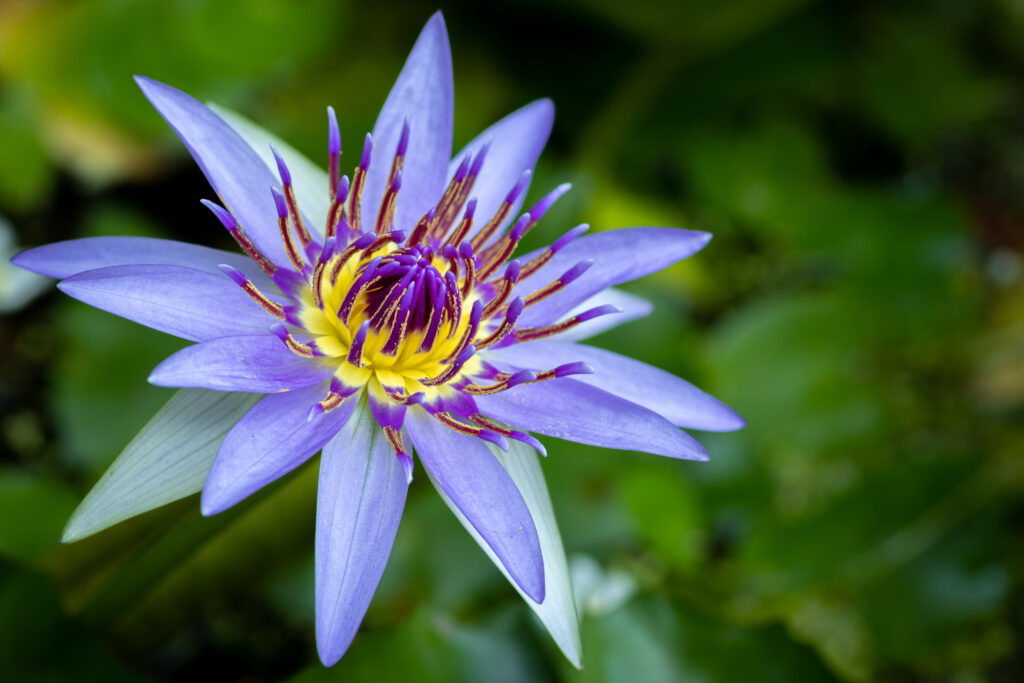
Nymphaea flowers come in several species and vivid colors.
©Nilanka Sampath/Shutterstock.com
2. Narcissus
Classification: Narcissus sp.
The daffodil, sometimes referred to as the Narcissus flower, is a mesmerizing springtime flower that starts with N and charms with its vivid hues and unusual look. The trumpet-shaped blossoms and thin, elongated foliage of this perennial flower combine to produce a beautiful display of grace and elegance.
The Narcissus flower comes in a spectrum of hues, from bright yellows and whites to soft pinks and oranges. Its petals are in a circle surrounding a trumpet-shaped corona, which frequently has an accent color. The Narcissus flower’s distinctive structure is what gives it its familiar and iconic appearance.
Europe, North America, and Asia are just a few of the places in the world where Narcissus blooms may be seen growing. They flourish in moderate regions and are especially common in gardens, meadows, and wooded areas. These hardy flowers frequently announce the start of spring with their vivid blossoms and can survive chilly conditions.
The symbolism of the Narcissus bloom is what sets it apart. It has various connotations in many cultures, including rebirth, regeneration, and fresh starts. The name Narcissus comes from a handsome young man who, in Greek mythology, fell in love with his reflection, giving origin to the term “narcissism.” Due to its alluring beauty, the flower got its name from this story.

Narcissus flowers are also known as daffodils.
©Andrew Fletcher/Shutterstock.com
3. Nierembergia
Classification: Nierembergia sp.
The Nierembergia flower, also known as the cupflower, is a delicate and enchanting flower that starts with N that mesmerizes with its dainty blossoms and unique features. This perennial flower showcases small, trumpet-shaped blooms that grow in clusters, creating a delightful carpet of color.
The Nierembergia flower’s petals are typically lavender or purple in hue, though there are varieties that display white, blue, or pink blossoms as well. The petals form a cup-shaped corolla, with a distinctively fringed or scalloped edge, adding to its ornamental appeal. The flowers are atop slender, wiry stems and lance-shaped, light green leaves compliment them.
Native to South America, particularly Argentina and Uruguay, the Nierembergia flower thrives in sunny or partially shaded locations. It is commonly in meadows, slopes, and rocky areas, where it spreads gracefully, forming charming ground cover. One can cultivate this versatile plant in gardens and containers, allowing its delicate beauty to adorn various landscapes.
What sets the Nierembergia flower apart is its ability to bloom profusely throughout the summer, showcasing a long-lasting display of color. The flowers are resilient, as they can withstand heat and drought conditions, making them a popular choice for low-maintenance gardens.
Just as well, the Nierembergia flower’s fragrance is another notable feature. Some varieties emit a sweet scent that attracts butterflies and other pollinators, enhancing the allure of this lovely flower.
4. Nasturtiums
Classification: Tropaeolum sp.
The Nasturtium flower is a vibrant and distinctive flower that starts with N that delights with its colorful blooms and edible attributes. This annual flower displays a unique charm, making it a favorite in gardens and landscapes worldwide.
Nasturtiums are characterized by their rounded, shield-shaped leaves and showy, trumpet-shaped flowers. The flowers come in a wide range of striking hues, including shades of orange, red, yellow, and cream. Some varieties even exhibit bi-color or variegated petals. The distinctively shaped leaves are often aloft on long, trailing stems, adding to the plant’s decorative appeal.
Originating from South America, particularly Peru, and Bolivia, Nasturtiums spread across many regions and are in gardens far and wide. They thrive in sunny locations but can also tolerate partial shade. These versatile plants thrive cascading from hanging baskets, climbing trellises, or carpeting the ground as ornamental ground cover.
What makes Nasturtiums truly unique is their dual purpose as both ornamental and edible plants. The flowers and leaves of Nasturtiums are not only visually appealing but also add a peppery and slightly tangy flavor to salads and other culinary creations. This culinary versatility, combined with their vibrant blooms, makes Nasturtiums a popular choice for edible landscapes and kitchen gardens.
Just as well, Nasturtiums are known for their resilience and ability to attract beneficial insects such as bees and butterflies, promoting pollination and biodiversity in the garden. They are also recognized for their potential to repel certain garden pests.
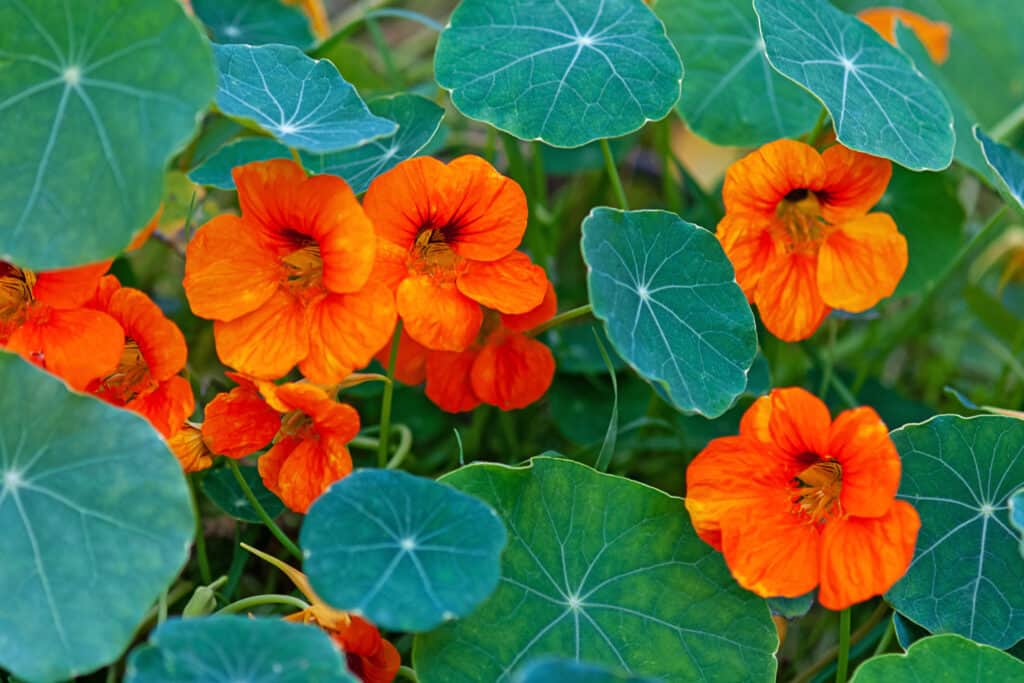
Nasturtium flowers are quite popular for creating ground cover in gardens.
©iStock.com/Nadya So
5. Nemesia
Classification: Nemesia sp.
The Nemesia flower is a charming and delicate flower that starts with N that captivates with its petite blossoms and delightful fragrance. This annual or perennial flower is native to South Africa and belongs to the family Scrophulariaceae.
Nemesia flowers possess small, tubular blooms that grow in clusters along slender stems. The petals come in a wide array of vibrant colors, including shades of pink, purple, yellow, orange, and white. The flowers often showcase two upper petals and three lower petals, creating a distinctive and intricate shape. Their alluring fragrance is reminiscent of honey or vanilla, adding to their appeal.
Nemesias thrive in cool and temperate climates. They prefer full sun or partial shade and well-draining soil. These versatile flowers are in gardens, borders, containers, and rockeries, where their vibrant colors and delicate form add a touch of elegance.
What makes Nemesia flowers truly unique is their ability to bloom profusely, producing a continuous display of color throughout the growing season. They are known for their resilience and adaptability to a variety of growing conditions. Moreover, their captivating fragrance attracts pollinators such as bees and butterflies, enhancing the garden’s biodiversity.
Nemesias are also appreciated for their versatility in landscaping. They are in use as bedding plants, border edging, or as a charming addition to mixed flower arrangements. Their compact size and vibrant blooms make them a popular choice for adding splashes of color and charm to various outdoor spaces.
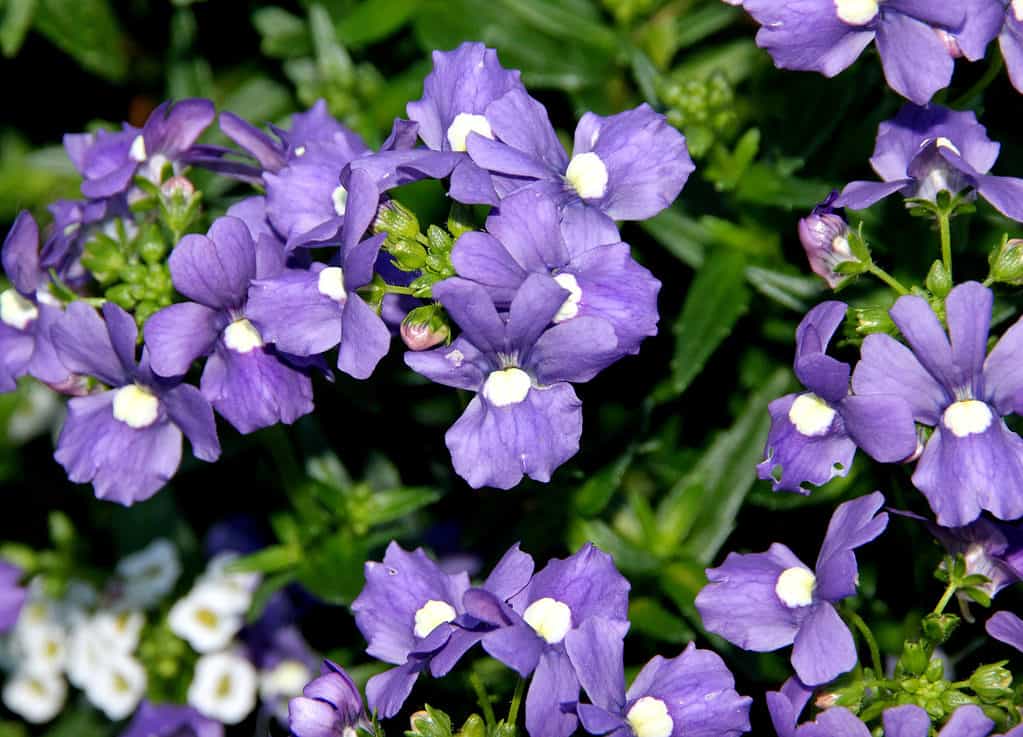
Nemesia flowers are known for being very adaptable landscaping plants.
©Gurcharan Singh/Shutterstock.com
6. Nemophila
Classification: Nemophila sp.
The Nemophila flower, also known as baby blue eyes, is a delicate and enchanting wildflower that starts with N. It captivates with its charming appearance and unique characteristics. This annual flower is native to California and is in some parts of Oregon and Mexico.
Nemophila flowers are known for their exquisite beauty, showcasing dainty, cup-shaped blossoms in shades of soft blue, sky blue, or white. The petals often feature intricate patterns of contrasting colors or delicate speckles, adding to their visual appeal. The flowers are atop slender stems with fern-like leaves, creating a graceful and airy appearance.
These lovely flowers thrive in cool, coastal climates and are typically in woodland areas, meadows, or along shaded stream banks. They prefer well-draining soil and partial shade, though they can tolerate some sun exposure.
What makes Nemophila flowers truly unique is their striking color and delicate form. Their gentle blue hues evoke a sense of tranquility and serenity, making them a popular choice for gardens and floral arrangements. Their compact size and low-growing habit also make them ideal for border plantings or as a groundcover.
Nemophila flowers are beloved for their ability to attract pollinators such as bees and butterflies, contributing to the overall biodiversity of the ecosystem. Their ephemeral beauty, combined with their adaptability to various growing conditions, makes them a cherished sight in springtime landscapes.
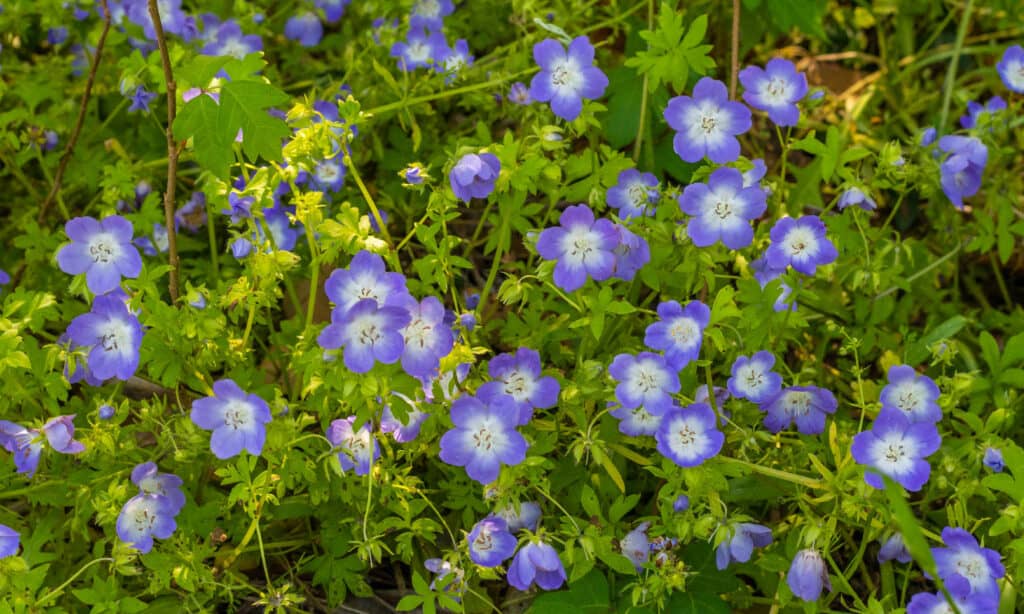
Nemophila flowers do well in cool, coastal regions.
©Marianne Pfeil/Shutterstock.com
7. Nigella
Classification: Nigella sp.
The Nigella flower, also known as Love-in-a-Mist, is an intriguing and exquisite plant that stands out with its delicate blooms and unique seed pods. This annual flower belongs to the Ranunculaceae family and is native to Europe, North Africa, and Southwest Asia.
Nigella flowers showcase intricate and lacy petals that come in a variety of colors, including shades of blue, purple, pink, and white. The petals form a star-like shape, surrounding a central cluster of stamens and pistils. What makes Nigella truly distinctive are its fascinating seed pods, which resemble small, spiky balloons and add an element of intrigue to the plant.
These captivating flowers are growing in gardens, meadows, and open fields. They prefer well-drained soil and thrive in full sun to partial shade. Nigella possesses resilience and the ability to tolerate dry and hot conditions, making it a popular choice for xeriscaping and low-maintenance gardens.
What sets the Nigella flower apart is its seed pods, which develop after the petals have fallen. These decorative pods are in use in dried flower arrangements, adding texture and visual interest. They also hold edible black seeds that have a mild, peppery flavor, which can be used in culinary applications and as a spice.
Just as well, Nigella flowers have a charming folklore associated with them, representing love, beauty, and transformation. Their delicate appearance and intriguing seed pods make them a favorite among gardeners and flower enthusiasts alike.
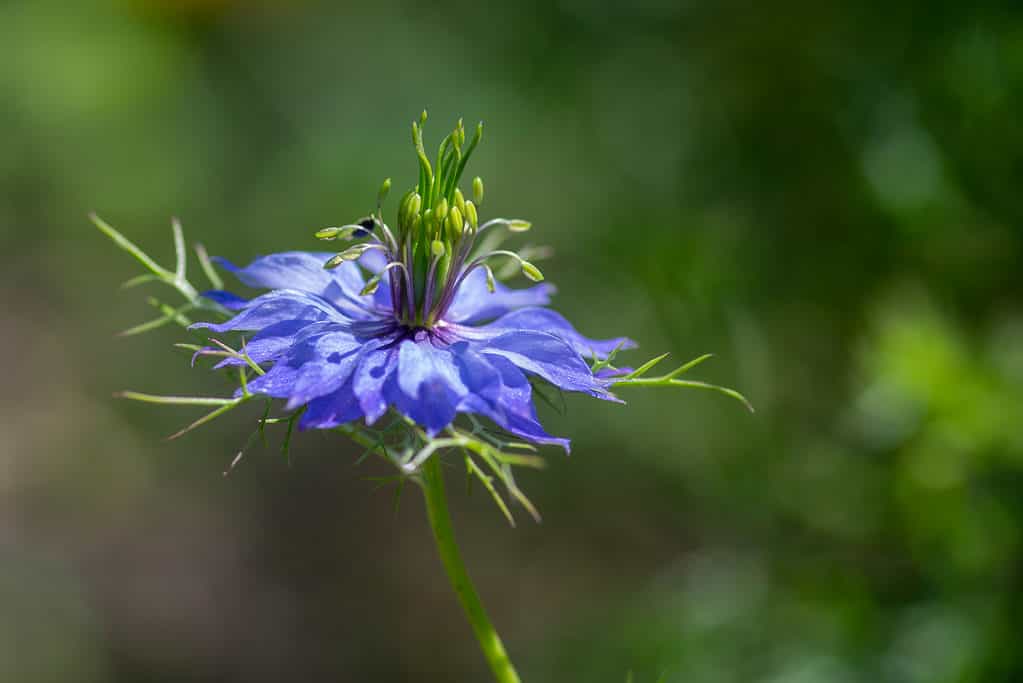
Nigella flowers possess unusual petal shapes and overall appearance.
©Iva Vagnerova/Shutterstock.com
8. Nicotiana
Classification: Nicotiana tabacum
The Nicotiana flower, sometimes referred to as the tobacco plant, is an alluring and adaptable blooming plant that draws admiration for its beautiful flowers and strong scent. The Solanaceae family, which includes this annual or perennial flower, is indigenous to the Americas.
Nicotiana blooms occur in a variety of hues, such as white, pink, red, and lavender variations. They feature tubular flowers with five petals that spread out to resemble trumpets. The blossoms frequently release a fragrant and seductive aroma that draws moths and other pollinators, especially in the evening.
Around the world, you may find these beautiful flowers blooming, especially in warm, tropical areas. They love well-draining soil and do well in either full sun or light shade. The cultivation of Nicotiana plants in gardens, borders, and containers enhances the beauty and smell of outdoor areas.
The significance of Nicotiana in both history and culture is what truly sets it apart. Some grow several species of Nicotiana for their leaves, which are in use for smoking, chewing, or snuff. The plant is widely recognized for its role in the manufacturing of tobacco. It’s crucial to keep in mind that ornamental Nicotiana cultivars are often planted for their beauty and smell rather than for the production of tobacco.
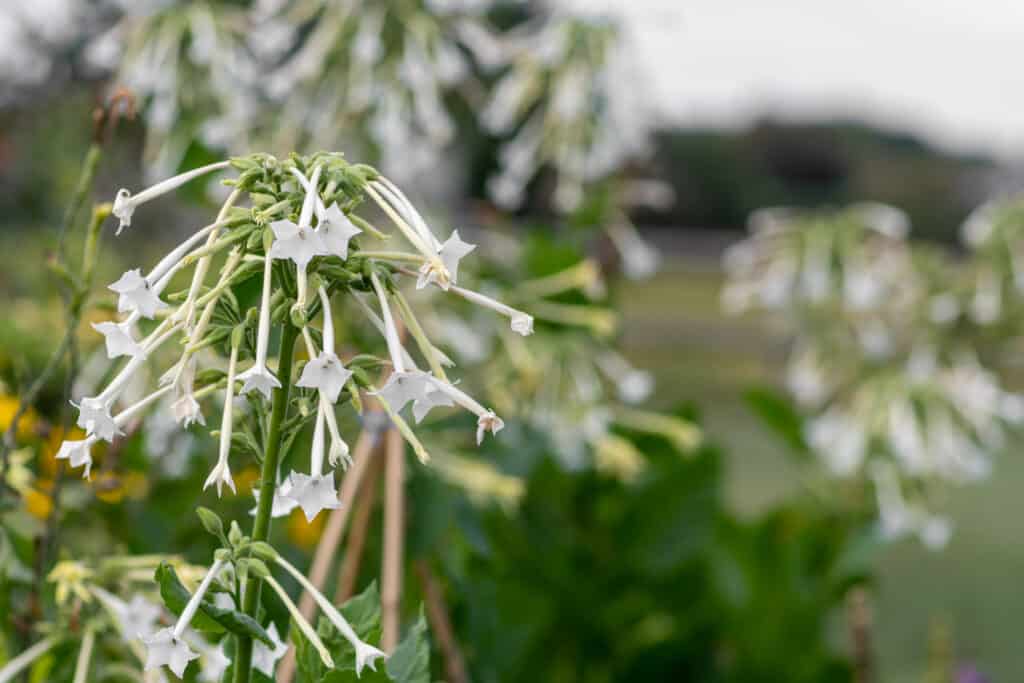
Flowering tobacco is a common and quite lovely addition to flower gardens.
©iStock.com/Tom Meaker
9. Night Phlox
Classification: Zaluzianskya capensis
The Night phlox flower is a captivating and unique plant that enchants it with its mesmerizing blooms and delightful fragrance. This perennial flower is native to South Africa and possesses distinctive characteristics.
Night phlox flowers boast petite, star-shaped blossoms that come in shades of white, pink, or purple. Their delicate petals are often fringed or toothed, adding to their visual appeal. What makes the Night phlox truly remarkable is its enchanting fragrance, which intensifies during the evening hours, attracting pollinators such as moths and other nocturnal insects.
These charming flowers are growing in various regions with well-draining soil and moderate sunlight. Night phlox is often cultivated in gardens and containers, where its unique beauty and captivating scent can be enjoyed up close. It thrives in temperate climates and is typically an annual in cooler regions.
What sets the Night phlox flower apart is its ability to release its fragrance during the night, hence its name. This unique characteristic allows it to attract pollinators that are active during nighttime. The fragrance is often described as sweet, spicy, or even reminiscent of honey, adding a touch of enchantment to evening gardens.
10. Nerine
Classification: Nerine sp.
The Nerine flower, also known as the Guernsey lily or spider lily, is an exquisite and distinctive plant that mesmerizes with its striking blooms and unique characteristics. This perennial bulbous plant is native to South Africa and belongs to the Amaryllidaceae family.
Nerine flowers showcase tall, slender stems topped with clusters of vibrant, trumpet-shaped blooms. The petals come in a range of captivating colors, including shades of pink, red, orange, and white. The petals often display a delicate, wavy texture, adding to their visual allure. The flowers are complemented by long, strap-like leaves that emerge from the base.
Nerine flowers typically bloom in late summer or autumn, adding a burst of color to gardens and landscapes. They prefer well-drained soil and thrive in full sun or partial shade. Nerines are in various regions worldwide, but they are particularly prevalent in Mediterranean climates.
What makes the Nerine flower truly unique is its ability to bloom during the autumn months when many other flowers have finished flowering. This late-season blooming habit adds a touch of vibrancy and elegance to gardens, making it a cherished choice among gardeners.

Nerine flowers are known for their unusual yet stunning petal shapes.
©iStock.com/Tom Meaker
More Gorgeous Flowers That Start With N
| Rank | Flower | Classification |
|---|---|---|
| 1 | Nymphaea | Nymphaea sp. |
| 2 | Narcissus | Narcissus sp. |
| 3 | Nierembergia | Nierembergia sp. |
| 4 | Nasturtiums | Tropaeolum sp. |
| 5 | Nemesia | Nemesia sp. |
| 6 | Nemophila | Nemophila sp. |
| 7 | Nigella | Nigella sp. |
| 8 | Nicotiana | Nicotiana tabacum |
| 9 | Night Phlox | Zaluzianskya capensis |
| 10 | Nerine | Nerine sp. |
| 11 | Nolana | Nolana paradoxa |
| 12 | New Guinea Impatiens | Impatiens hawker |
| 13 | Neomarica | Neomarica sp. |
| 14 | Nepeta | Nepeta sp. |
| 15 | Nettle-Leaved Bellflower | Campanula trachelium |
| 16 | New York Ironweed | Vernonia noveboracensis |
| 17 | Nicandra | Nicandra physalodes |
| 18 | Night-Flowering Catchfly | Silene noctiflora |
| 19 | Nodding Wakerobin | Trillium flexipe |
Thank you for reading! Have some feedback for us? Contact the AZ Animals editorial team.

